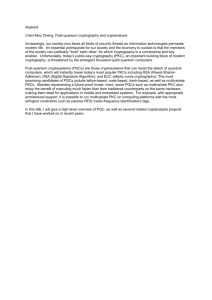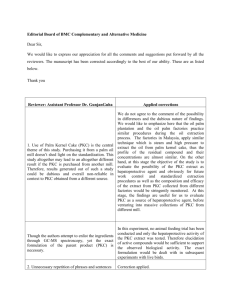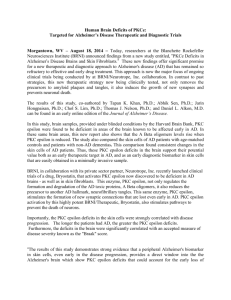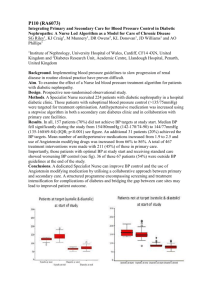Scientific novelty of paper
advertisement
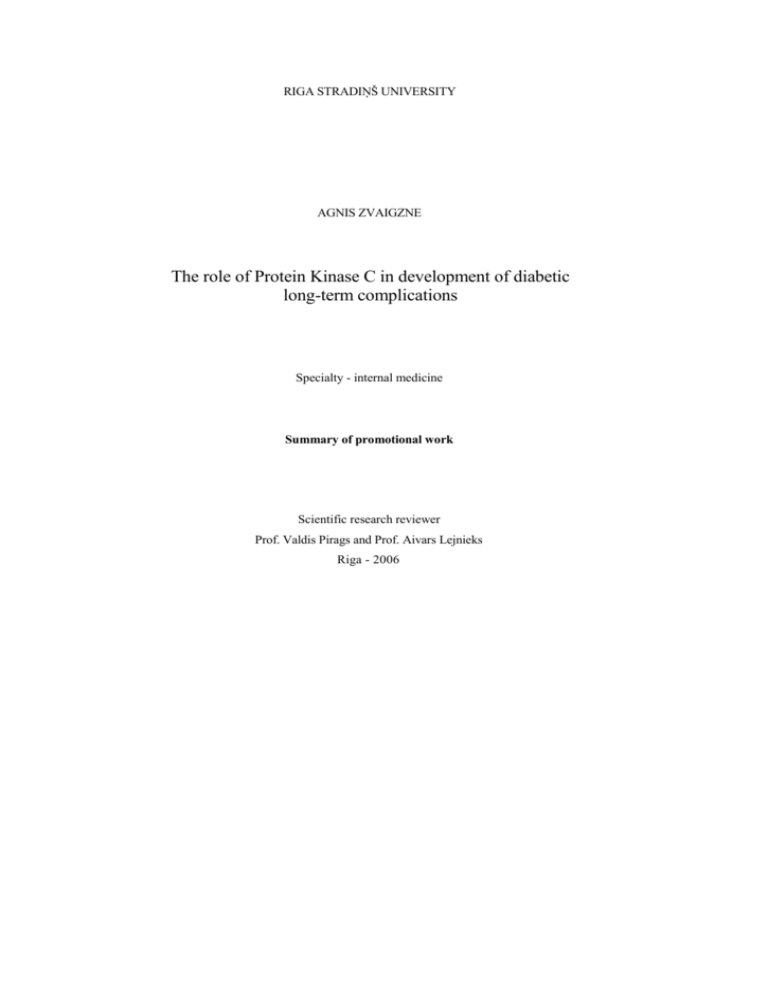
RIGA STRADIŅŠ UNIVERSITY AGNIS ZVAIGZNE The role of Protein Kinase C in development of diabetic long-term complications Specialty - internal medicine Summary of promotional work Scientific research reviewer Prof. Valdis Pirags and Prof. Aivars Lejnieks Riga - 2006 Topicality of the paper Diabetes is known from ancient times and nowadays it has become a global health problem. It is most common metabolic disorder and according to World Health Organization 171 million people are affected worldwide. The incidence of diabetes is increasing with civilization. According to forecast already in 2030 year this disease will affect more than 366 million. Due to widespread incidence and expensive treatment it becomes as significant financial issue for healthcare. For instance in United State of America every dollar from each seven dollars dedicated to healthcare is spent for diabetic patients. Currently more that 42 000 diabetic patients are registered in Latvia. Even more are undiagnosed, which makes more complicated to treat long-term complications, such as retinopathy, nephropathy and macro vascular complications. This is reason for the search after new medications that possible could prevent development of long-term complications. More and more the roles of PKC in development of long-term complication and its possible prevention by inhibition of PKC is discussed. Currently several trial testing specific PKC inhibitors are ongoing. Unfortunately the results are controversial so far. More studies about PKC involvement in development of diabetic complication would help to create effective medicine. Purpose and task of scientific work To identify the role C peptide as one of plasma factors i9n development of diabetic long-term complications. Research tasks necessary for the reaching the purpose of scientific work. 1) Clarify hyper reagibility of PKC 1 in diabetic patient versus healthy volunteers. 2) Identify different plasma factors e.g. C peptide effect on PKC 1, in platelets. 3) Clarify the role of different parameter (creatinin, HBAIC) on hyper reactivity of PKC 1 in platelets. Scientific novelty of paper Identification of different PKC 1 activation factors (e.g. C peptide) we can see those patients who eventually will be in need of treatment with principally new group of medication called specific PKC 1 inhibitors. Structure and scope of the paper The papers are written in Latvian language and consist of the introduction, literature survey, description of methods used in the research, highlight of the results gained, discussion, conclusion, practical recommendations a list of literatures used. The scope of the paper is 78 pages, 17 graphics and 4 tables. Material and methods In the first step of study 26 patients with poor compensation of diabetes and significant insulin resistance were included. Two patients had creatinin above upper norm limit, however general in groups this parameter were within normal ranges. Detailed description of patients can be found in table 1. Table 1. Characteristics of diabetic patients and healthy volunteers. All date expressed as mean + SD Control group was composed from 9 healthy volunteers that have been age, lender and (body mass index) BMI matched to diabetic patients. All healthy volunteers were screened for diabetes. None of healthy volunteers had positive history of cardiovascular disease. In the second step 16 patients with type 1 diabetes and 16 healthy volunteers as control group were included. Detailed description of both groups can be found in table 2. Control group was age, gender and BMI matched to diabetic patients. All healthy volunteers were screened for diabetes. None of healthy volunteers had positive history of cardiovascular disease. All individuals before enrolment into study signed informed consent forms. Table 2. Characteristic of diabetic patients and healthy volunteers. All date expressed as mean ± SD Methods Platelets were isolated from diabetic and healthy volunteers whole blood by two steps centrifugation. After incubation according protocol citozolic and membranous fracture were prepare by repeated centrifugation. The protein concentration was measured by using Bradford method. The proteins were divided according to the size by SDS-polyacrilamid gel electrophoreses as described. Proteins were transferred to membrane by electro blotting. PVDF membranes were precipitated with primary antibodies of PKC 1 with following imunoprecipation of secondary antibodies. PKC 1 was visualized by hromogenic substrate. Quantitations of PKC 1 signals were performed by densitometry. For statistically analysis of results Wilcoxon program was used. All data are expressed as mean ± standard deviation Results Isolation of platelets and purity of samples The purity of samples was detected by microscopy in randomly chosen samples as shown in table No.3 there was contamination with erythrocytes and leucocytes. However as described in discussion it may affect study results. Table 3 The purity of samples was. All results are expressed as mean ± standartdeviation Content of citozolic and membranous PKC in type 2dibatic patients and healthy volunteers. The content of PKC 1 in diabetic patients before incubation was greater than in healthy volunteers. However this difference was not statistically significant. The content of citozolic fracture was greater as in membrane both in diabetic patients and healthy volunteers and it was statically significant. Results are showed in graphic 1. Graphic 1. PKC 1 in cytosol amd membrane. Comparison of diabetic patients to control group. All results are expressed as mean value. 24-hour incubation Statistically significant increase with a pick after 6 hours in citozolic fracture was observed both in diabetic patients in healthy volunteers. Diabetic patients had statistically significant greater increase as control group. Statistically significant difference between both groups was observed after 4, 6, 8, 10 hours of incubation. No statistically significant changes were caused by incubation in membrane. Also no statistically significant difference was observed between diabetic patients and control groups in regards of membranous fracture. Effect of C peptide Incubation of 15 minute did not caused any effect to PKC 1 in platelets. While incubation of 30, 60, 90, 120 minutes caused 132, 173, 147, 141% increase, respectively. Incubation without C peptide caused increase cytosolic PKC 1 after 60, 90, 120, 180 minutes. Comparing incubation with and without C peptide statistically significant difference between those two was detected after 30 and 60 minutes. The results are shown in graphic No 2. Incubation with or without C peptide did not cause any effect on membranous PKC. According to results 60-minute incubation were chosen for further experiment. Graphic 2. Effect of C-peptide and incubation on PKC 1 in different time points. Comparison of diabetic patients to control group. All results are expressed as mean value Incubation of platelets in different concentration of C peptide caused following changes: 50 nmol concentration did not caused any changes in both citozolic and membranous PKC 1. 200 nmol concentration caused significant increase in citozolic fracture while no effect on membranous fracture. 600 nmol concentration increased previously described effect on cytozolic fracture without affection of membrane. Similar results were obtained by incubation 1000 and 1500 nmol. However no linear increase of PKC 1 activation was observed. Results are showed in graphic 3. Graphic 3. Effect of different concentrations of C-peptide to PKC 1 in platelets of diabetic patients in 3 samples. All results are expressed as mean value. 200 and 600 nmol C peptide effect on PKC 1 According to above-mentioned results we choused 200 and 600 C peptide concentration for further investigation. Incubation in 200 n/mol C peptide caused statistically significant increased in citozolic PKC 1 in diabetic patients. Also in healthy volunteers this concentration caused statistically significant changes, which disappeared after correction of results by eliminating effect of incubation. The difference between diabetic patient and healthy volunteers were statistically significant. Similar effect was observed with incubation of 600 nmol C peptide. Results are showed in graphic 4. No statistically significant differences were observed between 200 and 600 nmol concentration. No effects were observed in membranous*PKC 1 Graphic 4. Effect of C-peptide to PKC 1 in platelets. All results are expressed as mean value. * Statiscicaly significant. Discussion The study was performed into two parts. The second part was carried out to identify factors involved in PKC (3i effects observed in first part of study. In contrast of the first part, in second part we involved into study type 1 diabetic patients. Our choice was based on fact that type 1 diabetic patients have absolute insulin deficit. Therefore we excluded long-term effects of C-peptide to platelet PKC 1 Nowadays due to distinguish etiology and pathogenesis type 1 and type 2 diabetes is considered as two separate diseases. However two significant facts should be taken in account by analyzing this study. First, both types of diabetes share the most pivotal symptom, which is hyperglycemia. Second, they both have identical pathogenesis and clinical manifestation of long-term complications. The research object of this study was long-term complications which incidence was similar in both groups. Exception was microalbuminuria, which was more frequently observed in type 2 diabetic group. However, the difference was not statistically significant. Also it is known that presence of nephropathy do not affect activity of PKC 1. Statistically significant differences were in BMI between both groups. Which was greater in the patients participating in the first part of study. There are date about correlation between BMI and activity of PKC 1 in endothelial cells. However studies with platelets did not demonstrated correlation between those two. Remarkable difference between two groups was in current ant diabetic treatment. All patients involved in the first part of study received multiple insulin injections while patients involved in second part of the study received exclusively oral anti diabetic medications. As described before PKC 1 can be suppressed in results of insulin therapy. However this effect can be observed only in patients with wellcontrolled diabetes. As seen from table No. 1 all patients involved in second parts of the study were with poorly controlled diabetes. Remarkable differences between two groups were in time since diagnoses of diabetes. We excluded this parameter from analysis as noninformative. Decision was based on facts that diagnosis of type 2 diabetes is usually delayed. The purity of samples As seen from table 3 the samples were contaminated by erythrocytes. However it is not likely that present of erythrocytes affected the results of study due to very small amount if PKC 1 and erythrocytes. The sample contamination with leukocytes were non significant based on this fact all results reflect PKC 1 activity in platelets. The content of PKC 1 in platelets of diabetic patients compared to healthy volunteers Our results demonstrated increased PKC 1 content in diabetic patient, which reflect to previously published results. However this difference was not clinically significant. The content of citozolic fraction was greater as in membranous in both: diabetic patients and healthy volunteers. This phenomenon can be explained by fact that most cells are in inactivated state e.g. in citozol. However discussable question is why diabetic patient who have hyper reactivity of PKC 1 have similar proportion of citolotic - membranous PKC 1 as a healthy volunteers. More over the extraction of membranous fracture is longer and more complicated process as extraction of citazolic fracture. In result significant amount of membranous PKC 1 can be last during the process. We did not find previously described negative correlation between kidney functions that PKC in platelets. As described before PKC can be suppressed by insulin therapy. Most patients with chronic kidney failure are treaded with insulin therapy. It is likely that previously described correlation can be rather related to effect of insulin therapy that to kidney function. IN our study both patients with increased level of creatinin were treated by sulfanylurea. The content of PKC 1 in platelets of those patients were similar as in group in general. Also we did not find correlation between PKC 1 and such parameters BMIandHBAlC. Effect of incubation Incubation caused increase of PKC 1 with a pick of effect after 6 hours and following stable decrease. Observed significant decrease after 24 hours is not likely due to process in a cell itself, rather it can be explained by decrease of number of platelets after incubation. The mean decrease of platelets in samples after 24 hors was 37%. Our result demonstrates synthesis pf PKC 1 of platelets. Significant increase of PKC 1 of citozolic fracture cannot be explained by PKC 1 translocation from membrane to citozol, as we observed increase of total amount of PKC 1. In our study we did not analyzes citoscelet fracture of PKC 1 According to previously published data the amount of PKC 1 in this fracture is similar to citozlic. In our study we observed i ncrease of citizolic fracture by 512% therefore this cannot be explained by translocation of PKC 1 from citoskelet to citoplazm. As mentioned above approximately 37 % of platelets die during the 24 hot of incubation. Theoretically there is possibility that PKC 1 release from died platelets travel through membranes into leaving platelets. According to this theory maximal increase of citozolic fracture could be 59% while in our study increase 512 % was observed more over the pick was detected after 6 ours of incubation when lost of platelets were minimal. Also the observed difference between diabetic patient and healthy volunteers cannot be explained by distinguish survival of platelets because non of the previously performed studies have shown decrease survival of platelets in diabetic patient even more survival of platelets is not effected by poorly controlled diabetes. Synthesis of protein in platelets is described previously more over in 1992 mRNA responsible for PKC 1 syntheses were identified in platelets. However none of previously performed studies have demonstrated PKC 1 synthesis. Also the difference between distinguish condition in synthesis of PKC 1 is nor analyzed. The results of our study demonstrate increased PKC 1 syntesis in platelets of diabetic patients. The results of first part of the study did not identify responsible factor of increase synthesis. According to study protocol platelets were incubated in plasma were many factors are present. It is known that chronic hyperglicemia can activate PKC 1. However the studies with short-term hypergleasemia neither did nor caused activation of PKC 1 in aorta. Experiment with human platelets has shown even small decrease of PKC as result of acute hyperglycemia this phenomenon has been described both in citozol and membrane. Short-term incubation in vitro demonstrated ability to activate PKC 1 by sub maximal stimuli independently of glycemia. According to all above-mentioned studies, increased PKC 1 synthesis of PKC 1 in platelets cannot be explained exclusively by increased glycemia in diabetic patients. Effect of C peptide Currently published articles focused mostly on beneficial effect of C peptide to diabetic long tern complications. However recently performed studies demonstrated that damaging role of C peptide to development of macrovascular complications. For instance one study has shown increase detonation of C peptide in early arteriosclerosis. We performed the second part of study to identify the factors responsible for PKC 1 activation. Most type 2 diabetic patients have increased level of C peptide. Also the patients involved in first part of out study reflect this phenomenon. In order to precise dosing of C peptide during incubation and to exclude possible chronic effect of C peptide. In the second part of out study we involved patients with type 1 diabetes who have absolute insulin deficiency. It was confirmed by laboratory. To exclude effect of incubation we performed parallel platelet incubation in HEPES buffer without C peptide. The results obtained from incubation with C peptide were corrected with results obtained from incubation without C peptide. Therefore C peptide results were isolated and expressed in graphics. We observed effect of C peptide already in physiological concentration. Similar effects were observed previously by Kitamura et.al. In his study incubation of fibroblasts in presence of 200 n/mol caused mythogen activated protein kinase fosforilation with a following activation of its cascade. It is known that PKC 1 place pivotal role in this activation. In order to prove the effect of C peptide to PKC 1 specific PKC 1 inhibitor was added to incubation as in result activation of MAPK was blocked. Therefore confirming involvement of PKC 1 in this process. In our study we observed activation of PKC 1 in response to incubation with C peptide predominantly in diabetic patient. We hypothise that diabetes caused platelets modification that allows PKC 1 activation in response to physiological concentration of C peptide. Likely specific C peptide receptor are involve in this process. Analyzing results from second part in contest of first part we observed greater synthesis of PKC 1 in response to incubation in plasma comparing to incubation in HEPES buffer with C peptide. Despite clear demonstration of syntheses of PKC 1 in platelets in response to C peptide it is likely that plasma contains some not identified factors that take part in complex activation of PKC 1 Interesting are results obtained from incubation in different concentration of C peptide. As showed above at some point of concentration plato of PKC 1 activation is reached. Therefore it is likely that platelet contains specific C peptide receptor. Until now specific G protein coupled C peptide receptors on platelets surface are not decreased. However the results of our study is motivation for further investigation and identification C peptide receptors, which would give as better understanding of the role of C peptide in pre diabetes stage. Conclusions. 1) Platelet PKC has different reagibility in diabetic patients compared to healthy volunteers. 2) C-peptide has direct effect on platelet PKC beta 1 isoform 3) Apart from C-peptide plasma contains not identified factors which contributed to activation of PKC Practically recommendation 1. For patient with increased risk of cardiovascular disease C peptide must be evaluated. 2. Evaluation of compensation of diabetes must include not only HBAIC and fasting plasma glucose, but also post-prandial glycemia. 3. In treatment of diabetes eventually should include specific PKC 1 inhibitors.
